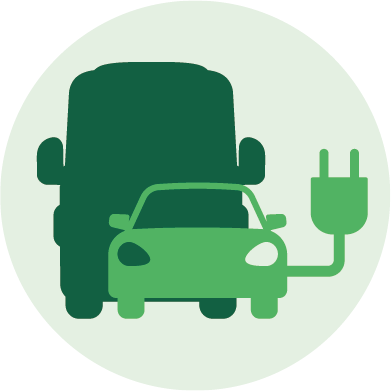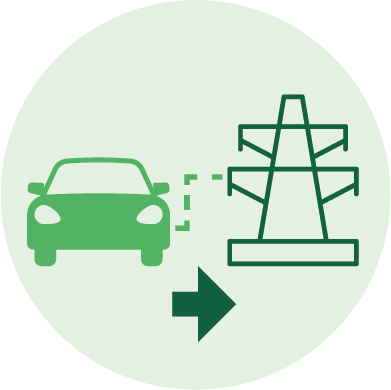Transport Sector

Transport sector
The transport sector is a critical pillar in Belgium’s decarbonization strategy, yet its rising demand across all transport modes poses a significant challenge. Achieving climate targets in this sector requires more than just reducing emissions from inland mobility—it also demands action on international transport, which plays an increasingly important role.
Given Belgium’s strategic geographic position in Europe and its extensive infrastructure links with neighboring countries, reducing international transport emissions—particularly from aviation and shipping—will be a driving force in Belgium's decarbonization strategy. At the same time, the European Union’s ambitious continent-wide decarbonization targets emphasize the importance of cross-border cooperation.
To reflect these developments, the updated PATHS2050 framework now includes international transport, with a specific focus on aviation and maritime shipping. This update aligns with new EU-level policies aimed at accelerating the decarbonization of these sectors and ensures that Belgium's strategy remains comprehensive and future-proof.
Inland Transport
Transport within Belgium remains one of the most energy- and carbon-intensive sectors. Since the majority of inland transport is road-based, it remains heavily dependent on fossil fuels, which currently account for 95% of total energy demand. As a result, the sector emits approximately 27 MtCO₂ per year.
However, results from our modeling indicate that reducing fossil fuel dependence—and achieving significant emissions reductions—is both feasible and cost-effective, as long as targeted solutions are implemented across different transport subsectors.
The primary driver of decarbonization is the electrification of road transport, which is already progressing rapidly—especially for passenger cars and freight vehicles—and is expected to accelerate over the next 5 to 10 years. This transition, while ambitious, is realistic, given the current trajectory: electric vehicle (EV) sales more than tripled between 2022 and 2024, and are projected to double again in the next three years.
This deep electrification effort will result in a 40% reduction in transport sector emissions by 2030, and over 95% by 2040, by which time electrification of the road transport fleet is nearly complete.
To support this transformation, investments in EVs must be accompanied by the large-scale deployment of charging infrastructure. Our model results show that Belgium will require at least 1.5 million charging stations by 2050 to support the transition and offer flexibility services to the electricity grid (smart charging and vehicle-to-grid).
Inland Transport
Final Energy Consumption
Emissions
KEY TAKEAWAYS
-
By 2030, there are almost
2 millions EVs
in the country, requiring a doubling of the EV sales in the next 3 years

-
By 2050, all road transport is
fully electrified

-
By 2050, EVs are powered by at least
1.5 million
charging stations, about half which are smart and 350.000 use V2G

International Transport
International transport plays a pivotal role in Belgium’s energy system, encompassing both maritime and aviation sectors. Thanks to the strategic importance and scale of the Port of Antwerp-Bruges, maritime transport accounts for a substantial portion of energy consumption. At the same time, international aviation also contributes significantly. Combined, these two sectors represent over 20% of Belgium’s total energy demand—one of the highest shares among EU member states. This underscores the magnitude of the challenge in decarbonizing international transport.
In response to this, and in line with evolving EU climate policy, both sectors are now covered under the Emissions Trading Scheme (ETS). Furthermore:
International maritime transport is required to achieve full decarbonization by 2050, and
International aviation must reduce emissions by 70% under the ReFuelEU Aviation initiative.
These regulatory milestones set the course for deep transformation, calling for a mix of alternative fuels, efficiency improvements, and technological innovation across both sectors.
International Shipping
Decarbonization of maritime transport will be driven by a combination of fuel shifts and fleet modernization. By 2040, dual-fuel ships are expected to represent more than 40% of the fleet, contributing to a first reduction in fossil fuel demand thanks to their higher efficiency, and in emissions due to the use of liquified natural gas in place of diesel or heavy fuel oil. By 2050, over 60% of the fleet could be composed of dual-fuel ships, enabling the flexible use of multiple low-carbon fuels. These fuels include:
Locally produced biomethane, which will double the size of today’s biogas market, reaching 6–7 TWh/year;
Imported synthetic methane, potentially rising to 50 TWh, equivalent to 25% of current natural gas imports;
Biodiesel blending, which will also contribute to emission reductions.
The fleet transformation will also involve a shift toward alternative propulsion systems. Depending on the scenario:
Up to 30% of ships could be powered by ammonia, particularly for extra-EU long-distance shipping;
Electric propulsion may dominate shorter intra-EU routes, offering zero-emission mobility over limited ranges.
However, a critical variable across all scenarios is the global fuel price trajectory. Since all decarbonization strategies depend heavily on imported fuels, the cost-effectiveness of each pathway is highly sensitive to international market conditions. As such, future fuel prices will play a decisive role in shaping Belgium’s most viable maritime decarbonization route.
Energy Consumption
Emissions
International Aviation
The decarbonization of international aviation will primarily depend on the import of e-kerosene and bio-kerosene, both of which are drop-in fuels that can be used in existing aircraft engines with minimal technological adjustments. An added advantage is that these fuels utilize the same transport and storage infrastructure as conventional kerosene, making them a practical and scalable near-term solution.
By 2030, sustainable aviation fuels (SAF) will already represent over 20% of the sector’s fuel mix. This share is projected to increase to nearly 45% by 2040, and reach 75% by 2050, corresponding to a total SAF consumption of approximately 16 TWh.
As with international shipping, the choice of fuel will be heavily influenced by global import prices. Given the cost sensitivity of high-utilization technologies like aviation, operational costs will be a key factor in determining the most cost-effective decarbonization pathway.
Energy Consumption
Emissions
KEY TAKEAWAYS
-
By 2050, the maritime sector will need
up to 50 TWh
of imported e-methane, equivalent to a quarter of today’s natural gas imports

-
By 2050, Sustainable Aviation Fuels (SAF) will dominate nearly
75%
of the aviation fuel market


